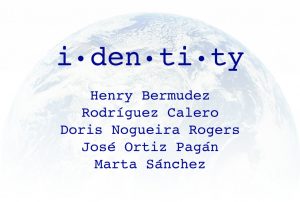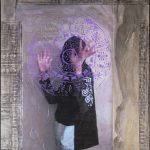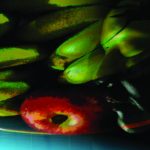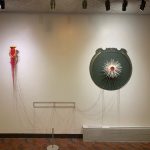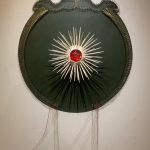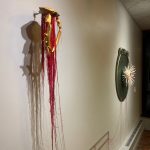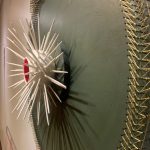January 17 – February 25, 2022
Online exhibition catalog
A recording of the Feb 10 artists’ panel discussion can be found here
Identity is a word known by everyone in the world, but is it truly understood? Of course, every human being on earth has an identity consisting of qualities, beliefs, personality, expressions that make a person who they are and special. Indeed, identity is unique and differs by country, culture, and traditions. Today, our “Identity” exhibition explores a special side of uniqueness. The current exhibit highlights Philadelphia area artists of Central American, South American, and Puerto Rican heritage, with the common theme of identity and a particular focus on culture and family origin. Henry Bermudez, Rodríguez “Roca” Calero, José Ortiz-Pagán, Doris Nogueira Rogers, and Marta Sánchez are the artists that chose to share with us a glimpse of their experiences, stories, and feelings that belong to their identity. Today, while they live on the east coast of the United States and have adopted this country as a part of their identity, their cultures remain a significant component of their incredible art. Using fascinating and revolutionary varieties of mediums, these artists present us with fantastic artworks inspired by childhood memories, exciting travels, family traditions, personal feelings and perceptions, and current social issues both in their country and in the United States. We hope that this exhibition will allow people to reflect on their own identity while learning a better visual and emotional understanding of these artists’ cultures. So today, as you stand in front of these artworks, remember the uniqueness that makes you, the person next to you, and the artists.
~ Rebecca Elbaze
Gallery Exhibition Research Assistant
Henry Bermudez
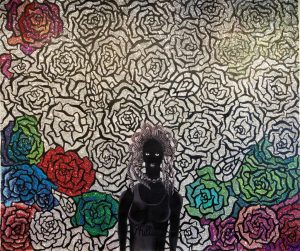
Philadelphian Girl, Acrylic and Glitter on Canvas, 2021
Henry Bermudez’s Philadelphia Girl is directly inspired by the artist’s identity that has traveled and significantly evolved with time. After graduating from art school in his home country of Venezuela, Henry Bermudez became an art teacher in the small town of Borubes. Created as a plantation to cultivate sugarcane, Borubes saw the coming of many African slaves. As a result, and after much time and effort, Borubes became rooted in African traditions, music, dance, mythology, and culture. That became a part of the artist’s identity and influenced his art. The complex background filled with prominent flowers reflects the artist’s idea of landscape, as he remembers from his many visits to the Amazon’s bountiful forest. Further, the mesmerizing glitters and colors are influenced by the artist’s experience living in Mexico and Peru. Philadelphia Girl represents the artist’s identity, traveling and picking up pieces of different cultures. Today, after 19 years of living in Philadelphia, Henry Bermudez proudly says that he also feels like he belongs to the city’s culture without forgetting his past experiences, which are all feelings reflected in this artwork.
~ Rebecca Elbaze, Gallery Exhibition Research Assistant
Rodriguez Calero

Rodríguez Calero, The AmeRícan Tragedy, 2019, Fotacrolé mm on canvas
The AmeRícan Tragedy is a poignant artwork that embodies deep meanings and sentiments. Two handcuffed individuals stand in front of a small Puerto Rican flag layered upon the prominent American flag. Roca says that this imagery is inspired by Puerto Rican Poet Tato Laviera and his work in which he is yearning for the Utopian Society, which in reality does not exist. The artist’s message behind the creation of this piece is both emotional and political. Indeed, the artist notes that “Puerto Ricans continue to be subjects of the United States without a right to vote for the president, without voting representation in Congress and equal treatment compared with citizens born or naturalized in the United States.” The paper towel acting as handcuffs symbolizes what critics said about Trump’s inability to sympathize with others and his self-absorbed leadership in a time of crisis. The AmeRícan Tragedy uses Fotacrolé mixed media, which evolved from Roca’s visual fields of expression, such as photography, acrollage painting, and collage. This form grew from a physical, emotional, and developmental need to revitalize the artist’s creative processes.
~ Rebecca Elbaze
Gallery Exhibition Research Assistant
Rodríguez Calero, nuYoRican Experience 2015, Archival pigment print
The series of three nuYoRican Experience canvases contains bright images layered upon each other. The elements included in the canvases are meant to integrate and maintain strong and deep ties between the island of Puerto Rico and New York. With the meditative woman’s face, exotic fruits, pastel blue sky with clouds, and fluttering trees, the nuYoRican Experience canvases blend two worlds that make the artist’s identity.
~ Rebecca Elbaze
Gallery Exhibition Research Assistant
Doris Nogueira Rogers
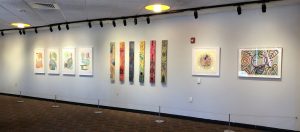
Amazon’s Genesis Series, Wood Cut, 2021
The neo-abstract series is Doris Nogueira Rogers’ most recent work. Created during the pandemic’s challenging lockdown, Amazon’s Genesis is inspired directly by the Brazilian nature that always fascinated Doris. The artist’s connection to nature is profound. While growing up in the populated industrial city of Rio de Janeiro, Doris would find peace in the tropical forest and sea that surround Brazil. Further, Amazon’s Genesis reminds her childhood and home as she remembers her grandmother’s garden filled with colorful orchids, a greenhouse, and tropical flowers. Doris would sketch botanical watercolor from prints gifted by her brother as a child. Today, she revisits her original sketches of leaves and pods with these intricate and colorful patterns. Each canvas contains deep symbolism to remind the viewers of the importance of nature. For instance, the floating brown lines in each canvas represent the illegal logging of wood in Brazil, which often leads to deforestation. Amazon’s Genesis is a powerful series that connects one culture to another that all can relate to and feel because, as Doris says, nature is everywhere and can be found all around us.
~ Rebecca Elbaze, Gallery Exhibition Research Assistant
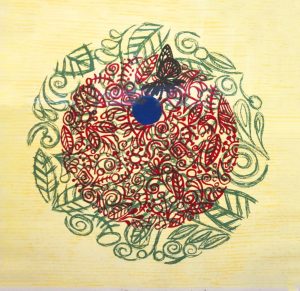 Brazil Deconstructed, Serigraph, 2018
Brazil Deconstructed, Serigraph, 2018
With its tinted light-yellow background and green and red layered circles, Brazil
Deconstructed embodies both the artist’s family traditions and the Brazilian society. The red and green circles layered upon each other contain intricate and elaborate patterns, including natural elements such as leaves. This artwork takes Doris back to her family tradition or detailed crochet and embroidery work which the women in her family were masters of. The choice for this imagery is an homage to the artist’s grandmother, whom she remembers was perhaps the best at embroidery and loved watching her do the craft. The colors are also meticulously chosen to remind of the Brazilian flag but with tinted tones. That is to show that despite being layered, they are separated elements. Painted in 2018, during the Brazilian presidential elections, this symbolizes how society in Brazil can often become divided after one is elected to power as any other place on earth. The black butterfly, often seen as a symbol of joy and happiness, is trapped in the middle. Doris’ artwork shows that someone’s identity is a blend of happy memories that follow even through the most challenging times.
~ Rebecca Elbaze, Gallery Exhibition Research Assistant
Jose Ortiz Pagan
“Partida”
Dimensions variable, mixed media installation, 2022
Jose Ortiz-Pagan’s two prominent pieces continue a series of works he has long worked on. Growing up in Puerto Rico, the artist was surrounded by the sea and developed a spiritual and meditative relationship with the ocean. The sea is vast and allows for infinite traveling during one’s lifetime. The two pieces together reflect this idea and the concept of transition as part of one’s unique identity. Jose explains that a person does not truly have one set identity. Instead, it is continually transitioning with life’s experiences.
With its long and dense red strings, the crab displays signs of transition by bleeding out its identity to allow new experiences into itself. Similarly, the sea urchin at the center of the circular piece turned white as in real life when they died, all while retaining a vivid red at its heart. Unlike the sea urchin that can only live at the bottom of the sea, the crab can settle in the water, on rock, or land. While both pieces are different, they become connected by a few red strings to suggest the continuing transition. The circular part is almost entirely made of papier-mâché and wood surrounded by nails and detailed golden strings. The crab includes a natural upper shell ending with papier-mâché and touches of gold.
~ Rebecca Elbaze, Gallery Exhibition Research Assistant
Marta Sanchez
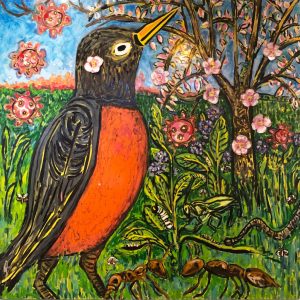 Marta Sanchez, Corona Spring, oil and enamel on tin, 4’x4’ 2020
Marta Sanchez, Corona Spring, oil and enamel on tin, 4’x4’ 2020
Since its beginning, the pandemic has been a challenge for everyone worldwide, regardless of one’s identity. The artist says, “Coronavirus didn’t care of what economic, social, or cultural upbringings you had; it touched everyone.” Yet, while all of us remained locked in our homes, nature prevailed and continued to thrive. Martha always loved witnessing the change of the seasons from her window, “but,” Martha says, “the spring of 2020 was different, like the novel Silent Spring, it was looming with environmental overtones. Only this time, it wasn’t a sci-fi book by Ray Bradbury or a segment of Twilight zone. It was real.” As a Latina, the artist knows too well the feelings of fear and vulnerability that her culture experienced. Yet, for once, everyone shared these feelings and tried to survive and make each passing season the best possible. Regardless, it is essential to remember that with or without us, the robins will enjoy the cherry blossoms during the season.
~ Rebecca Elbaze
Gallery Exhibition Research Assistant
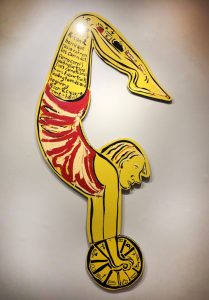 Marta Sanchez, The Acrobat, oil and enamel on tin
Marta Sanchez, The Acrobat, oil and enamel on tin
The Acrobat is part of the artist’s train series depicting the Mexican experience with the building of train yards in Mexico and America. The inspiration behind the choice of depiction is directly connected to the artist’s grandmother, who was part of a Mexican vaudevillian troop known as Las Carpas. The Acrobat’s legs are filled with parts of a poem by poet and folklorist Norma E.Cantú incorporated in their collaborative suite of prints, Transcendental Train Yards. The poem is based on the children’s song “R con R cigarro,” which is a song that teaches them how to roll their “r’s.” The poem begins with this song and shifts to convey more significant concerns in life’s journeys as a Mexicano/a, Chicana/o, Latina/o in modern-day times.
~ Rebecca Elbaze
Gallery Exhibition Research Assistant
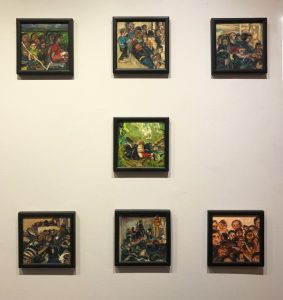 Marta Sanchez, 7 paintings of detention and immigration, oil on masonite
Marta Sanchez, 7 paintings of detention and immigration, oil on masonite
Marta Sanchez has long been involved and interested in researching detained immigrants’ lives before and during COVID-19. By creating these seven paintings, the artist wanted to acknowledge and share the painful existence immigrants too often go through. During the past few years, immigration ethics have been a primary concern globally, and “artists have the ability to bring the world around us into other realms,” Marta says. The seventh painting in the center depicts a father and toddler daughter drowned together swimming to the other side of the border. For the artist, this image is the most painful and heartbreaking but will last a lifetime in the minds of its audience.
~ Rebecca Elbaze
Gallery Exhibition Research Assistant

